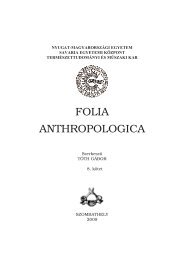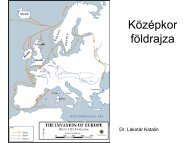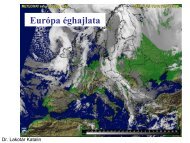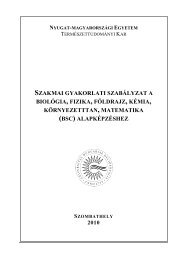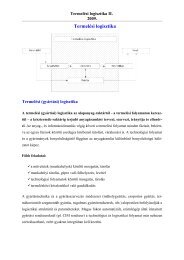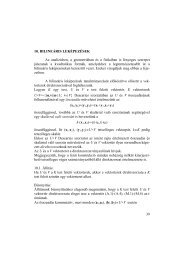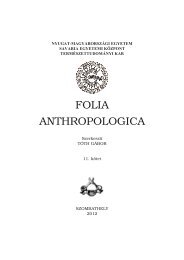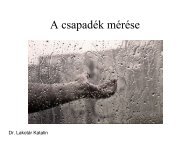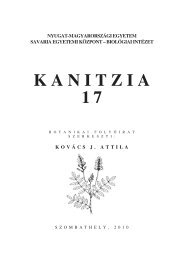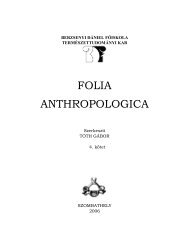Kanitzia 18. - NYME Természettudományi Kar - Nyugat ...
Kanitzia 18. - NYME Természettudományi Kar - Nyugat ...
Kanitzia 18. - NYME Természettudományi Kar - Nyugat ...
Create successful ePaper yourself
Turn your PDF publications into a flip-book with our unique Google optimized e-Paper software.
Key words: Krascheninnikovia ceratoides, steppic and dry grasslands, Agropyro cristati-Krascheninnikovietum<br />
ceratoidis ass. nova, Transylvanian Basin, Romania<br />
Introduction<br />
The species Krascheninnikovia ceratoides (L.) Gueldenst. (English name: Vinterfat,<br />
Hungarian name: Pamacslaboda) with a large holarctic distribution mostly in Central<br />
Asia and the Far East is considered as an Eurasian (Eurosiberian) floral element with particular<br />
(mongolian-tibetan-himalayan and anatolo-irano-turanian-pontic) characteristics and<br />
with isolated population-stands in Central Europe and in the Mediterranean area (MEUSEL<br />
et al. 1965, HEGI 1979, SOÓ 1970, ADLER et al. 1994, OPREA 2005). This monoecious halfshrub<br />
species of Chenopodiaceae (Amaranthaceae s. l.) with more frequent syno-nyms used<br />
Eurotia ceratoides (L.) C. A. Mey. and Ceratoides latens Reveal & N. H. Holmgren, is a<br />
cold tolerant and drought-resistant plant, which today presents a wide vege-tation ecology,<br />
growing from the mountainous cold semi-deserts, shrub desert steppe, dry grasslands and<br />
dry steppe habitats, to the semi-alkali and gypsum vegetation types also. In Europe during<br />
the Pleistocene last glacial (Würm/Weichselian) periode the species distribution have been<br />
more extensive, the plant was a common participant of the cold dry climate of the<br />
periglacial landscape (BORISOVA et al. 2007, HEKLAU & RÖSER 2008). So the actually disjunct<br />
area, the isolated population-stands from Europe must be considered as relicts of cold<br />
subdesertic steppes of the periglacial climate of cca 18, 000 years ago (BELL M. & WALKER<br />
1998, ZELIKSON 1998). The cold dry steppe vegetation received probably new steppe elements<br />
from the wooded steppe persisted in favourable microsites of the Carpathian Basin<br />
during the late glacial interstadial and Holocene (SÜMEGI et al. 2002, MAGYARI et al. 2010).<br />
Concerning the taxonomical position and the possible relative taxa of the species,<br />
the common botanical literature recognized to this time cca seven species of the genus<br />
Krascheninnikovia (ILJIN 1936, GRUBOV 1999, ZHU GELIN et al. 2003) distributed mostly<br />
in the large circumpolar area (Central Asia, Europe, North America, North Africa). Recent<br />
phylogenetic studies, using the anatomy and morphology of trichomes and the molecular<br />
analysis of the nuclear ribosomal ITS1-5.8S gene-ITS2 DNA (HEKLAU & RÖSER 2008)<br />
suggest to synonymise all previously described taxa of the genus under the single species<br />
of Krascheninnikovia ceratoides (L.) GUELDENST. [Syn.: Axyris ceratoides L., Eurotia ceratoides<br />
(L.) C. A. Mey., Ceratoides latens Reveal et N. H. Holmgren, Ceratoides papposa<br />
Botsch. et Ikonn., Ceratospermum papposum Pers., Krascheninnikovia latens J. F. Gmel.].<br />
After this conception the widely distributed species of Krascheninnikovia ceratoides (L.)<br />
Gueldenst. can be divided in two subspecies: 1. subsp. ceratoides (Eurasia), and 2. subsp.<br />
lanata Heklau & Röser. (North America). The subspecies ceratoides comprises the following<br />
traditional taxa: K. ceratoides (L.) Gueldenst. distributed in Asia and Europe, K.<br />
arborescens (Losink.) Czerep. in Inner Mongolia and China, K. compacta (Losink.) Grubov<br />
in China, K. eversmanniana (Stschegl. ex Borshch.) Grubov in China, Mongolia and Kazakhstan,<br />
K. pungens (Pazij) Podlech in Afghanistan and Uzbekistan, K. lenensis (Kuminosa)<br />
Tzvelev in west and east Siberia. The subspecies lanata Heklau & Röser (K. lanata (Pursh)<br />
A. Meeuse & A. Smit) is distributed only in western North America (Heklau & Röser 2008).<br />
Even either we use the traditional botanical literature or we accept the new taxonomic pro-<br />
60




